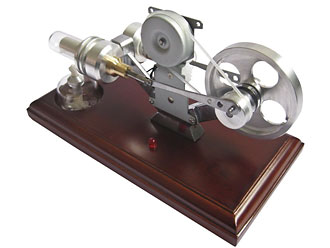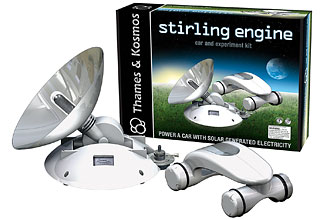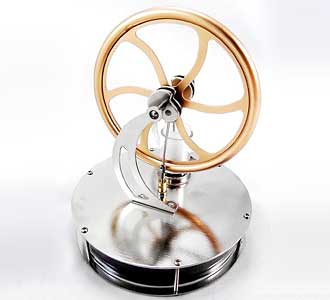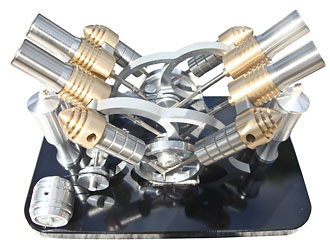Dave Kirk’s SV‐2 Stirling Engine Generator Project
The SV‐2 MKII Stirling Engine Generator on YouTube
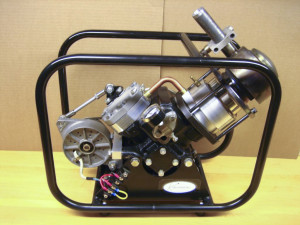
The other day I was going through the many Stirling engine generator videos on YouTube.
Most of the time I see small hobby type Stirling engines with little or no hope of generating usable electricity. Many of these Stirling projects are inspiring. However, few have a practical future as a Stirling engine generator. So I’m always a little excited to see an Stirling engine generator that shows promise.
Then I found the video of the SV‐2 MKII Stirling engine generator prototype that David Kirk of Kirk Engines, Inc. uploaded. The SV‐2 MKII is an alpha configuration Stirling designed using an automotive air conditioning compressor.
Stirling Engine Generator SV‐2 MKII by Kirk Engines, Inc.
It immediately reminded me of the Philips MP1002C Stirling engine generator. I even commented about it in the video comments section. As it turns out the Philips MP1002C did play an inspirational role in the birth of the SV‐2 MKII.
I decided I wanted to write a post about this project so I contacted David Kirk. David was very receptive to the idea and offered to write about the engine himself!
So with no further ado, here is David’s article on the SV‐2 MKII.
The SV‐2 Stirling Engine Project
By J. David Kirk
Inspired by the Philips MP1002C
During the mid 1980's, I had the pleasure of witnessing a Philips MP1002C generator set actually running. The experience made a deep impression on me, especially in how quietly the machine ran. The combustion burner contributed the majority of noise, but underlying this was the wonderful sound of the Philips engine ‐ all that could be noticed was the whir of the bearings.
As the old saying goes, "It ran just like a sewing machine"! At the time, my experience with Stirling engines consisted of designing a few desk-top-sized models, but after seeing and hearing the Philips engine run, I wanted to engineer, design, and construct an engine of this caliber…something that was big enough to do useful work.
I decided on an alpha-configuration engine for the following reasons
- This design has the largest swept volume per overall package volume, allowing for a physically compact engine.
- When constructed as a 90 degree V-twin, perfect primary balance can be achieved, contributing to smooth running
- The alpha V-twin is very mechanically simple, thus cost effective to construct
Pressurization
For a high-specific power output, pressurization is necessary. Knowing that the Philips engine ran at 12 bar (175 psi), I wanted to have an engine that was structurally strong enough to operate at these levels of internal charge pressure. Air was the working fluid of choice, due to practicality. And I wanted my engine to be oil lubricated just like the Philips engine ‐ this feature greatly contributes to the quiet operation and long life that is so desirable in a Stirling machine.
Chrysler Air-conditioning Compressor
About this time I had discovered a refrigeration compressor that appeared to be ideal as a basis for my planned engine. This was an auto air-conditioning compressor made by the Chrysler corporation, designated the RV-2. It was a 90 degree V-twin design, with a bore of 58.7 mm and stroke of 33.4 mm.
With both cylinders coupled with the proper gas path for Stirling engine operation, a swept volume of 127.8 cc's was realized (which is over double that of the Philips MP1002C engine). Being a refrigeration compressor, the construction was substantially strong enough for the charge pressures I was contemplating. In addition, this compressor featured a gerotor oil pump which pressure-lubricated the big ends of the connecting rod bearings. The aluminum pistons each had a single compression ring, and forged Alcoa aluminum connecting rods were used. This compressor seemed ideal for my intentions.
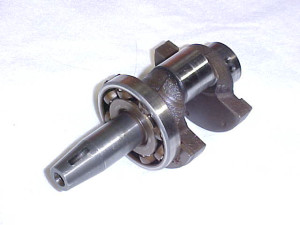

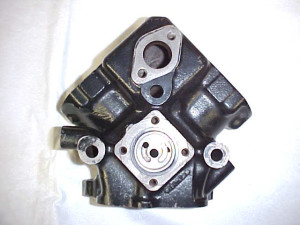
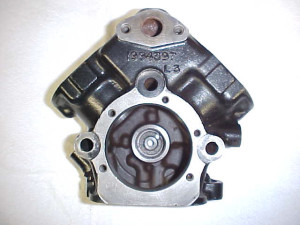
Years of Development
Over a span of several years, I designed and had machined all the necessary components to adapt the compressor to Stirling engine operation. I also made up a tubular carrying frame that supported the engine, styled similar to that used on the Philips generator set.
The heater head, displacer, and inner sleeve were made up from various sizes of 302 stainless tubing. A copper-wool regenerator was used. The cooler, located on the compression side of the engine, was made from billet aluminum. A small 200 Watt, 12 volt belt-driven alternator was purchased that was originally intended for use on a garden tractor.
This engine, dubbed the SV‐2 MK I (Stirling V-2 Mark 1), is shown below.

Initial Performance and Working Fluid
The engine did run, but performance was nowhere near the desired value. I tried Helium as the working fluid and this helped both power output and rpm, but it was very apparent that something was inherently wrong. The engine would run best at about 2 bar charge pressure at 2000 rpm, making about 50 watts electrical power…any more or less pressure and both speed and power output would be lost. Also, the engine block would become very hot after running for a relatively short time, indicating that heat transfer to the engine structure was excessive.
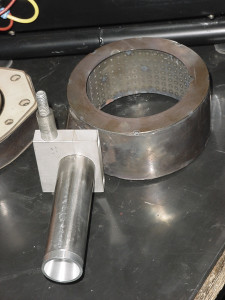
Engine Configuration and Trial and Error
After much thought (and several years of discouragement) I realized that errors existed in this configuration. First and foremost ‐ in any Stirling engine, the heater, regenerator, and cooler must be "close-coupled"; that is, placed in close proximity to each other. This means that these three thermodynamic components should all reside on the displacer side of the engine, instead of being spread over the entire gas path circuit as I'd done on the MK I. Such design subtleties are very important for good performance and this close-coupled arrangement is clearly apparent on all of the Philips engines. The fact that I'd placed the regenerator in intimate contact with the engine block contributed to the heat lost into the structure ‐ clearly not good Stirling design practice.
In spite of the poor performance, much was learned about oil control and how to eliminate lubricant migration into the working space. The combination of a snifter valve plus specially made, step-gap piston rings helped, along with some modifications to the piston ring grooves. Discovery of a non-carbon forming synthetic oil with a high flash point temperature was also an asset. Design of a proper, flame-impingement propane-fueled burner was a challenge, but after finding some old publications on the subject, a successful burner design scheme was arrived at and was verified successful on the third burner constructed.
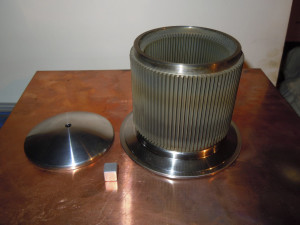
Redesign and the Birth of the MK II
At this point I realized that a major redesign was necessary if a good-performing engine was to be had. Delving into my technical references and books, I re-engineered all the thermodynamic components in the gas circuit to be state-of-the-art, with a no-expenses-barred approach. This included a 316 stainless heater head finned both internally and externally, a foil regenerator, finned cooler, and new thin walled stainless displacer.
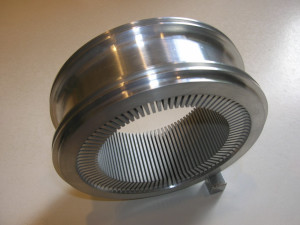
My friend and Stirling engine enthusiast John Archibald, agreed to produce CAD drawings from my design sketches and using his skills as a machinist, help with making some of the more difficult parts. It took several more years to obtain all the new components, but at the end of 2012, the MK II version of the engine was ready to be assembled.
Trail run of the SV‐2 MK II Stirling Engine Generator
The SV‐2 MK II was first run in January of 2013 and it was immediately apparent that the redesign had improved both the running quality and performance. The engine will run quite nicely when pressurized with air at 4 bar charge pressure, and as pressure is increased, rpm comes up proportionally. No power measurements have been made at this time due to the burner geometry not being correct for the new, finned heater head.
The assembled engine with generator installed, appears below:

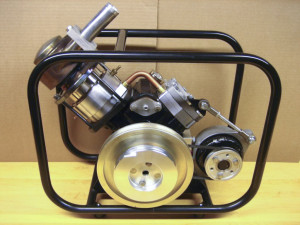
Water Cooling
As the engine is water-cooled, a small electric pump is employed for coolant circulation, being run off of a portion of the generator's output.
Further Development of the Burner
A new burner is now under construction that fits the finned heater head geometry and will produce higher heat output for the intended shaft output target of 700 watts @ 1800 rpm. This should be ready to test in another month or so, and should be totally adequate for investigating the full potential this engine has to offer.
Currently No Plans or Drawings for this Stirling Engine Generator
There are no plans to neither produce this engine nor sell drawings to make parts. It is strictly a research project to demonstrate the viability of such a product. The difficulty and expense in making some of the components remove it from being something the average hobbyist could construct. Also, there are compromises in using an existing machine, that being the RV-2 compressor, that would not be present in a clean-sheet design. If this present engine meets the performance targets the plan would be to use the thermodynamic components on a dedicated bottom end – that is, a new crankcase, pistons, rods, etc. This would be a product that may have some market potential.
Please watch for my new YouTube videos as the development progresses. I sincerely thank all of you for your interest!
Dave Kirk
Do you have a practical Stirling Engine Generator?
I’m always looking for more information and inspiration for the Stirling engine generator topic or any other Stirling engine topic. If you have an interesting design or you’ve found something that you think would be a good addition to DIYStirlingengine.com please leave a comment or Contact Me.

